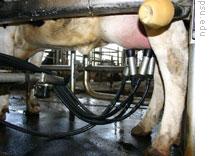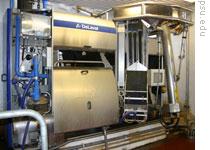This is the VOA Special English Agriculture Report.
Technology is making life easier for some dairy farmers. They use robotic systems to milk their cows. These systems are designed to reduce labor and increase milk production. Here is how they work:
 |
| A robotic milker at Mason Dixon Farms on the border of Pennsylvania and Maryland |
Cows are trained to follow a series of paths that lead to milking stations. Only one cow at a time can enter a station.
Once inside, the cow is rewarded with food. As the cow eats, a robotic arm cleans and connects the animal to the milking machine. A few minutes later, the milking is complete. The gate is lifted, the cow is released and the next cow enters.
The robotic systems are designed to operate twenty-four hours a day. The cows get to decide when they want to be milked. Cows are milked an average of about three times a day. Some are milked four to six times a day.
The cows wear collars around their necks that identify them to the system. A computer keeps records on their eating and milking. A cow is released from the station if the computer decides it should not be milked.
The automated system also measures the temperature and color of freshly produced milk. Milk is thrown away if it does not pass the tests.
 |
| A picture of the whole robotic milking system |
Cows need about two to four weeks to learn to use the robotic milking systems. Once trained, the cows no longer require human assistance, unless something goes wrong. The system is programmed to notify the farmer if there is a problem.
Karen Plaut heads the Department of Animal Science at Michigan State University. Professor Plaut believes the systems will appeal especially to the next generation of farmers. She means young people who are more interested in technology and less interested in working all the time on the farm. Still, she says the price of robotic milking systems will continue to limit their use.
Doug and Tina Suhr have more than one hundred milking cows on their family farm. Last year it became the fourth farm in southeast Minnesota to get a robotic milking system. A recent story in a local agricultural newspaper said the first robot cost one hundred seventy-five thousand dollars. The second cost one hundred fifty thousand.
Doug Suhr told Agri News that wages that would have paid for one employee will pay for one robot in five years. He says the increase in milk production reached a high of more than six kilograms per cow per day.
And that's the VOA Special English Agriculture Report, written by June Simms. I'm Bob Doughty.